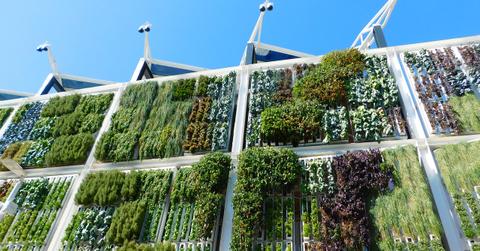World's Largest Vertical Garden Revives Downtown Bogota
A group of architects and landscape sculptors bring together the biggest vertical garden in the world, located in Colombia. Overtaking a local residential building, the plant-life aids in energy and water efficiency.
Updated May 22 2019, 4:49 p.m. ET
Rooftop gardens have been a classic move to keep urban areas fresh with growing plants. It’s important to keep our cities breathing by eliminating the carbon footprint set by humans. A building in Bogota, Colombia, has taken that to the next level by expanding the rooftop garden to the entire building itself.
The Edificio Santalaia building is located in the heart of downtown Bogota. It’s a multi-family residential building that’s easy to pick out among the tall and densely-populated area. The nine-story high structure is engulfed in plant wildlife; only windows, balconies, and the wall space between them can be seen of the original building.
Over 115,000 plants are installed in the massive garden. With over 3,000 square meters, or close to 32,300 square feet, of plant wildlife, that gives enough oxygen to over 3,000 people and replaces the carbon footprint of over 700. Plants include rosemary, asparagus ferns, and more from the local rainforests in Colombia. Perhaps one of the most unique aspects is the natural ability to better insulate the building itself. Temperatures are lower inside, and thus limits the use of air conditioning.
Paisajismo Urbano and Groncol were behind the architectural design. The latter company was successful in creating a greenwall on the B3 Hotel elsewhere in Bogota. Both companies created the idea for the Santalaia building in 2013. Planning and construction began in late 2014 and the building was completed in December of 2015.
There are over 42 irrigation systems in place to continually hydrate the plants. A crew of two people spend their entire workday maintaining the structure. General manager of Groncol, Pablo Atuesta, told Green Roofs how they also developed a system where any leftover water along with wastewater from the inhabitants are reused to help with the garden.
"Designing irrigation, water recycling systems, as well as plant selection were some of the biggest challenges with the Santalaia project. The Santalaia building is also using water from the apartments' showers for irrigation," Pablo continues. "Among many technical details we installed humidity and radiation sensors to optimize water consumption as well as a water treatment plant so as not to have any water waste."
Vertical gardens take many shapes and forms. While the Santalaia building is the largest in terms of area, the tallest vertical garden is found at One Central Park in Sydney, Australia. This building stretches up to 166 meters, or over 544 feet, high. Plants are littered all over the ledges of the skyscraper. Once dark, LED lights emit a beautiful show for many in the area. There are over 250 different species of local plants on the building.
These massive gardens give us great examples and brilliant ideas on how to give urban culture a healthy lifestyle. While it may look like plants are taking over abandoned buildings at first glance, these can ultimately add a gorgeous touch when properly cared for. The addition of reusing wastewater is also a unique benefit.
